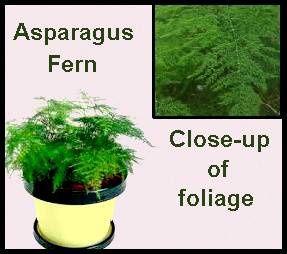 Plant Summary
Plant Summary
Botanical Name: Asparagus densiflorus 'Sprengeri'
Type: Foliage
Origin: South Africa
Height: The trailing stems of the Asparagus Fern can grow to a length of around 90 cm (3 ft).
Soil: A potting mix based on peat moss will keep the Asparagus Fern thriving.
Light: This house plant likes plenty of bright light, although too much sunlight may cause the leaves to drop. Keeping the plant in a position where it receives filtered light is therefore advisable.
Humidity: The Asparagus Fern prefers moist air, making it necessary to mist the leaves daily with water (room temperature) and keep the pot located on a tray with wet pebbles.
Temperatures: For this plant, average temperatures ranging between 16 and 24 degrees C (60 to 75 degrees F) will be ideal.
Water: The soil should be allowed to dry out just a little between thorough waterings. It is essential to avoid over-watering, as water is stored by the thick tuberous roots and too much water may cause the soil to become soggy. This may ultimately result in root rot. In winter, watering needs to be done more sparingly, but the soil should never be allowed to completely dry out, as this will cause the leaves to drop off.
Fertiliser: A diluted (1:1) balanced fertiliser for house plants should be given to this plant on a monthly basis from spring right into autumn.
Propagation: Propagation can be done from seed or by dividing a parent plant.
 Description and Care Tips
Description and Care Tips
The dense, needle-like short leaflets on the Asparagus Fern's long arching stems provide this house plant with a delicate appearance. Thanks to its cascading habit, it is perfect for use in hanging baskets.
In summer, mature plants will bloom, producing tiny flowers ranging in colour from white into a pale pink. These flowers may be followed by green berry clusters, which will turn red with the approach of winter. It should be noted that these berries are poisonous and should therefore not be eaten.
The emerald green, feathery foliage of the Asparagus Fern has long been a florists' favourite as an addition to bouquets. In temperate climates, it also makes a lovely outdoor plant. It should, however, be kept in containers, as it will be rather invasive if planted straight into the ground.
In its native habitat, this vigorous plant will spread with ease over and across other plants, often scrambling up larger plants as well.
 Pruning off older stems during the spring months will keep the plant looking neat and allow more room for fresh growth. Spring is also the best time to repot this house plant. Asparagus Ferns should be repotted into pots one size larger than the previous year, and approximately 2.5 to 5 cm (1 to 2 in) should be left between the top of the potting mix and the pot's rim. This will allow for a little growing space, as the tuberous, fleshy roots tend to push up the soil as they grow.
Pruning off older stems during the spring months will keep the plant looking neat and allow more room for fresh growth. Spring is also the best time to repot this house plant. Asparagus Ferns should be repotted into pots one size larger than the previous year, and approximately 2.5 to 5 cm (1 to 2 in) should be left between the top of the potting mix and the pot's rim. This will allow for a little growing space, as the tuberous, fleshy roots tend to push up the soil as they grow.




 Botanical Name: Syngonium podophyllum
Botanical Name: Syngonium podophyllum  Humidity: The Arrowhead plant is not terribly fussy about humidity levels and accepts average room humidity levels with ease.
Humidity: The Arrowhead plant is not terribly fussy about humidity levels and accepts average room humidity levels with ease.  Thanks to the efforts of commercial growers, this plant is now available in varieties that are more resistant to diseases, as well as in appealing compact variations. There are also more choices in leaf colours, some of which feature fairly heavy variegation.
Thanks to the efforts of commercial growers, this plant is now available in varieties that are more resistant to diseases, as well as in appealing compact variations. There are also more choices in leaf colours, some of which feature fairly heavy variegation.  The upright stems of young plants form in clusters and will develop into climbing stems as the plant fully matures. To give aerial roots something to cling on to and support older stems, moss sticks are the perfect solution.
The upright stems of young plants form in clusters and will develop into climbing stems as the plant fully matures. To give aerial roots something to cling on to and support older stems, moss sticks are the perfect solution. 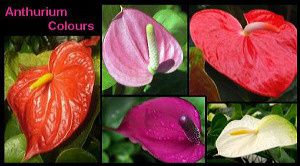 Botanical Name: Anthurium andraeanum
Botanical Name: Anthurium andraeanum  Water: This plant needs its soil to be kept evenly moist from spring through into autumn. During the winter months, it is acceptable to let the soil become a little drier, but not completely dry.
Water: This plant needs its soil to be kept evenly moist from spring through into autumn. During the winter months, it is acceptable to let the soil become a little drier, but not completely dry.  It should be noted that the long, leathery and deep green leaves of the Anthurium are poisonous. Containing calcium oxalate crystals, which can cause severe burns in the mouth, they should subsequently be kept well away from pets and small children. To avoid unpleasant skin irritations when handling this plant, it is advisable to wear protective gloves at all times.
It should be noted that the long, leathery and deep green leaves of the Anthurium are poisonous. Containing calcium oxalate crystals, which can cause severe burns in the mouth, they should subsequently be kept well away from pets and small children. To avoid unpleasant skin irritations when handling this plant, it is advisable to wear protective gloves at all times.  Anthuriums should only be repotted when necessary, and then only to a pot one size larger than the original. The crown of the plant should be left above the soil line. Drainage holes in the pot will prevent soil becoming too soggy.
Anthuriums should only be repotted when necessary, and then only to a pot one size larger than the original. The crown of the plant should be left above the soil line. Drainage holes in the pot will prevent soil becoming too soggy. 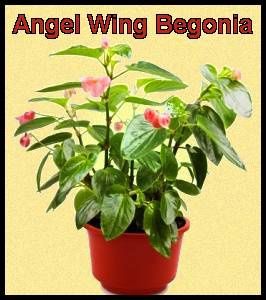 Botanical Name: Begonia x corallina hybrids
Botanical Name: Begonia x corallina hybrids  Water: The top 2.5 cm (1 in) of the soil should be allowed to dry out between watering, at which point it needs to be watered thoroughly.
Water: The top 2.5 cm (1 in) of the soil should be allowed to dry out between watering, at which point it needs to be watered thoroughly.  The big, glossy green leaves, elegantly shaped and often spotted with flecks of white, cascade down the cane like stems of the Angel Wing Begonia, ensuring it is perfectly beautiful even when not in bloom. This appearance is further enhanced by the reddish undersides of the leaves.
The big, glossy green leaves, elegantly shaped and often spotted with flecks of white, cascade down the cane like stems of the Angel Wing Begonia, ensuring it is perfectly beautiful even when not in bloom. This appearance is further enhanced by the reddish undersides of the leaves.  As begonias also like to have a little air circulating their roots, the soil should not be packed down too tightly. Drainage holes in the pot are necessary in order to prevent the soil from becoming soggy, which will cause the leaves to yellow and drop off.
As begonias also like to have a little air circulating their roots, the soil should not be packed down too tightly. Drainage holes in the pot are necessary in order to prevent the soil from becoming soggy, which will cause the leaves to yellow and drop off. 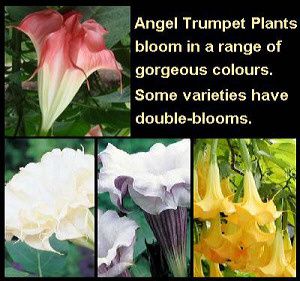 Plant Summary
Plant Summary  The Angel Trumpet Plant, a tropical evergreen that boasts extremely fragrant, large trumpet shaped flowers throughout summer and into autumn, requires plenty of sunlight, high humidity and warmth to thrive. Ideally kept in a sunny window, a sun room or a greenhouse, this plant can be placed onto a sunlit patio or porch during the summer months, as keeping it indoors may result in the fragrance becoming overpowering.
The Angel Trumpet Plant, a tropical evergreen that boasts extremely fragrant, large trumpet shaped flowers throughout summer and into autumn, requires plenty of sunlight, high humidity and warmth to thrive. Ideally kept in a sunny window, a sun room or a greenhouse, this plant can be placed onto a sunlit patio or porch during the summer months, as keeping it indoors may result in the fragrance becoming overpowering.  Cutting off spent flowers will encourage more blooms, as will pruning the plant after the flowers have faded. This will also help to keep the size of the plant under control. Essentially, up to half of the plant can be safely removed with each pruning and will ultimately result in increased numbers of flowers.
Cutting off spent flowers will encourage more blooms, as will pruning the plant after the flowers have faded. This will also help to keep the size of the plant under control. Essentially, up to half of the plant can be safely removed with each pruning and will ultimately result in increased numbers of flowers.  It is essential to look out for spider mites and immediately treat any infestations. Keeping humidity at high levels will also help to deter these pests, as they tend to prefer drier conditions.
It is essential to look out for spider mites and immediately treat any infestations. Keeping humidity at high levels will also help to deter these pests, as they tend to prefer drier conditions.  Botanical Name: Eucharis x grandiflora
Botanical Name: Eucharis x grandiflora  Description and Care Tips
Description and Care Tips  It is certainly worth giving this type of lily a try, as it is easy to grow and will provide beautiful flowers for years to come. The main point to remember is to provide good drainage in order to prevent over-watering.
It is certainly worth giving this type of lily a try, as it is easy to grow and will provide beautiful flowers for years to come. The main point to remember is to provide good drainage in order to prevent over-watering. 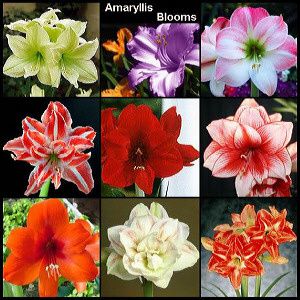 Botanical Name: Hippeastrum spp, hybrids
Botanical Name: Hippeastrum spp, hybrids  Because the over-sized, magnificent flowers of the Amaryllis have such a festive appeal, the bulbs are often sold in ready-to-grow kits during the pre-Christmas season. Easy to force into bloom during mid-winter by planting each bulb into a pot that is just big enough to hold it, with approximately a third of the bulb remaining above the top soil line, Amaryllis will start flowering within six to maybe eight weeks from planting.
Because the over-sized, magnificent flowers of the Amaryllis have such a festive appeal, the bulbs are often sold in ready-to-grow kits during the pre-Christmas season. Easy to force into bloom during mid-winter by planting each bulb into a pot that is just big enough to hold it, with approximately a third of the bulb remaining above the top soil line, Amaryllis will start flowering within six to maybe eight weeks from planting.  Once the leaves are brown, they can be cut off and the bulb needs to be stored in a paper bag for a minimum of two months in a dry, cool place (around 10 degrees C/ 50 degrees F) before planting it again for another crop of flowers. With a little tender loving care, Amaryllis plants will produce crops of gorgeous flowers for many years.
Once the leaves are brown, they can be cut off and the bulb needs to be stored in a paper bag for a minimum of two months in a dry, cool place (around 10 degrees C/ 50 degrees F) before planting it again for another crop of flowers. With a little tender loving care, Amaryllis plants will produce crops of gorgeous flowers for many years. 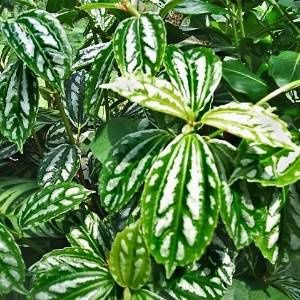 Botanical Name: Pilea cadierei
Botanical Name: Pilea cadierei  Water: The soil for this plant should be kept slightly moist from spring into autumn, but can be kept a little drier during the winter months.
Water: The soil for this plant should be kept slightly moist from spring into autumn, but can be kept a little drier during the winter months.  The perennial, fast growing Aluminium Plant has showy leaves that are splashed with silver, and, as well as being stunning, is fairly easy to grow. This, of course, makes it a very popular house plant, although it does have fairly high humidity requirements.
The perennial, fast growing Aluminium Plant has showy leaves that are splashed with silver, and, as well as being stunning, is fairly easy to grow. This, of course, makes it a very popular house plant, although it does have fairly high humidity requirements.  Older stems will naturally begin to drop their lower leaves and will need to be cut back a little in spring. If the amount of leaves that are dropped seems excessive, it may be a case of the plant being over-watered. While it likes high humidity, it does not like its soil to be soggy. Moving the plant to a warmer spot and waiting for the soil to dry out may help, otherwise the plant may need to be repotted in fresh, less soggy soil.
Older stems will naturally begin to drop their lower leaves and will need to be cut back a little in spring. If the amount of leaves that are dropped seems excessive, it may be a case of the plant being over-watered. While it likes high humidity, it does not like its soil to be soggy. Moving the plant to a warmer spot and waiting for the soil to dry out may help, otherwise the plant may need to be repotted in fresh, less soggy soil.  Description, Biology and Habitat
Description, Biology and Habitat 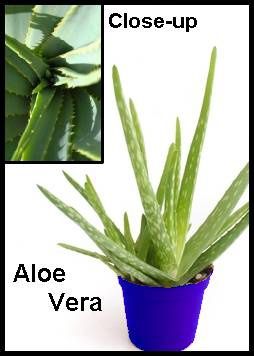 Botanical Name: Aloe barbadensis
Botanical Name: Aloe barbadensis  Temperatures: Ideally, Aloe Vera should be kept at room temperatures of between 18 and 24 degrees C (65 to 75 degrees F).
Temperatures: Ideally, Aloe Vera should be kept at room temperatures of between 18 and 24 degrees C (65 to 75 degrees F).  Description and Care Tips
Description and Care Tips